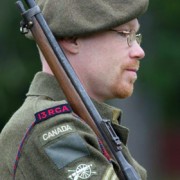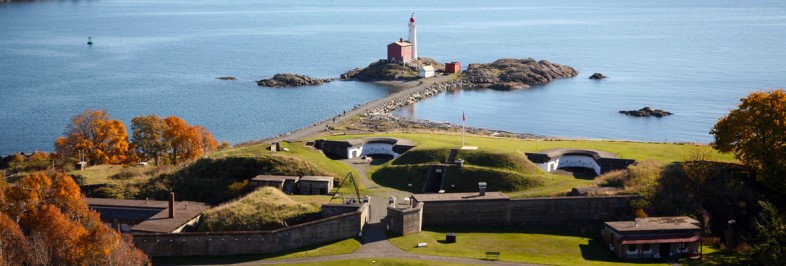
In his 15 years at Fort Rodd Hill National Historic site, Bob Campbell has gotten to know the place pretty well. We couldn't think of a better person to give us an 'insider's look' at this treasured Colwood site that is a point of pride for our region. Check our Community Events Calendar for fun stuff going on at the Fort.
Bob is Fort Rodd Hill's Collections Manager and Historic Weapons Supervisor. He's been at the site since 1998 and in that time has also worked as a front-line interpreter (historic guide) and volunteer coordinator.
What do you love most about your job at Fort Rodd Hill?
Interacting with visitors from all over the world.
What is your favourite part of Fort Rodd Hill?
I love learning about the social history of the Casemate Barracks where the soldiers lived. The site closed as a military base in 1956, so I have had the opportunity to speak with the actual people who worked and lived at the site. In my previous job with Parks Canada (at Fort Langley National Historic Site), there was little opportunity to speak with Chief Factor Mr. Yale or any of the men and women who lived the history.I'll always have a soft spot for Fort Langley and the fur-trade (I grew up there in the village) but here at Fort Rodd Hill the first-hand stories I hear are invaluable and really bring the history of the site to life.
Is there any memory that stands out from your time working at Fort Rodd Hill?
One of my favourite memories is meeting Phoebe Buxton (who was 97 at the time) and having her tour me around her old house. The Buxtons lived in the Warrant Officer's Quarters at the site and Phoebe was born upstairs in the main bedroom in 1911. Sadly, Phoebe has passed away but I believe she reached her 100th birthday in 2011. Her birth certificate (which she showed me) indicated she was born at "Rodd Hill Fort" and not Esquimalt or Victoria.
Do you have any surprising facts to share about the history of Fort Rodd Hill?
The guns at Lower Battery here at Fort Rodd Hill almost fired on 2 submarines that appeared under cover of darkness on August 4, 1914. These were two submarines purchased (illegally) by British Columbia Premier Richard McBride who believed the federal government wasn't doing enough to defend Canada's west-coast.
On his own initiative, McBride purchased the 2 subs from the manufacturer in Seattle where the subs were being built for the Chilean Navy. This was a huge risk in violating US neutrality and spending over a million dollars of provincial taxpayers' money.
At the last moment (literally!), right before the guns were fired, the gunners at Rodd Hill were informed that these were our own new Canadian subs and a disaster was averted. McBride managed to embarrass Prime Minister Robert Borden into purchasing the subs for the newly created Royal Canadian Navy and the province was reimbursed for their unorthodox purchase.
What do visitors usually love best about the site?
Many people are drawn to the site to see Fisgard Lighthouse. And as beautiful as Fisgard Lighthouse is, Fort Rodd Hill's history and the natural setting in the Garry Oak ecosystem is equally as impressive. Our unofficial motto is "Come for the lighthouse, stay for the fort". And that's what people usually do, whether they intend to our not.
What is the best time of year to visit Fort Rodd Hill?
A stroll through the quiet grounds is beautiful in any season, including storm watching over the panoramic ocean views in the winter. From the May Long Weekend through Labour Day there are many interesting and entertaining events going on at the site. And now visitors can even stay overnight at Fort Rodd in an oTENTik - a taste of outdoor camping adventure but with comfortable beds.
How many people visit Fort Rodd Hill each year?
You might be surprised to know that more than 50,000 people visit Fort Rodd Hill annually. So you'll be in good company when you drop by!
Read more about Fort Rodd Hill National Historic site on the Parks Canada website.



